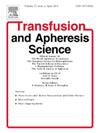Genetic characterization of an ABO*O.01.02-A2.05 hybrid allele associated with the Ael phenotype in a Chinese individual
IF 1.2
4区 医学
Q4 HEMATOLOGY
引用次数: 0
Abstract
Background
Discrepancies in ABO typing can arise from genetic variations, posing risks in transfusions. Traditional sequencing handles point mutations well but struggles with recombination events, which long-read sequencing can accurately identify. Here, we report a case of Ael phenotype associated with a novel recombination allele in the ABO gene in a Chinese individual.
Study design and methods
We used serological methods to identify the phenotype, and applied sequencing-based typing (SBT) and third-generation long-read sequencing (TGS) to determine the ABO genotype.
Results
Serological testing revealed an Ael subtype. SBT sequencing identified seven heterozygous mutation sites, with one allele hypothesized as ABO*O.01.01 (c.261delG). The remaining six variants did not match any known allele combination. Two ABO haplotype sequences were obtained through TGS. Analysis confirmed a second haplotype as a hybrid of O.01.02-A02.05, with the breakpoint located between c.220C>T (g.chr9: 133258116C>T; p.Pro74Ser) and c.239+103delCCC (g.chr9: 133257993delCCC) . The novel allele sequence has been submitted to GenBank (Accession number: OR2834978).
Conclusion
Our study demonstrates a case of a Chinese individual with an Ael phenotype caused by a novel allele resulting from the recombination of O.01.02 and A2.05. This finding underscores the significant advantage of long-read TGS technology in resolving structural variations.
与Ael表型相关的ABO* 0.01.02 - a2.05杂交等位基因的遗传特征
ABO血型的差异可能是由遗传变异引起的,这给输血带来了风险。传统测序能很好地处理点突变,但难以处理长读测序能准确识别的重组事件。在这里,我们报告了一例与ABO基因中一个新的重组等位基因相关的Ael表型在中国个体中的病例。研究设计和方法采用血清学方法鉴定ABO基因型,采用基于测序的分型(SBT)和第三代长读测序(TGS)确定ABO基因型。结果血清学检测显示为Ael亚型。SBT测序鉴定出7个杂合突变位点,其中1个等位基因假设为ABO*O.01.01 (c.261delG)。剩下的6个变异与任何已知的等位基因组合都不匹配。通过TGS获得了两个ABO单倍型序列。分析证实第二个单倍型为0.01.02 - a02.05的杂交,断点位于c.220C>T (g.c r9: 133258116C>;T;p.Pro74Ser)和c.239+103delCCC (g.chr9: 133257993delCCC)。该新等位基因序列已提交至GenBank(登录号:OR2834978)。结论本研究证实了一例由O.01.02和A2.05重组的新等位基因引起的Ael表型的中国个体。这一发现强调了长读TGS技术在解决结构变化方面的显著优势。
本文章由计算机程序翻译,如有差异,请以英文原文为准。
求助全文
约1分钟内获得全文
求助全文
来源期刊
CiteScore
3.60
自引率
5.30%
发文量
181
审稿时长
42 days
期刊介绍:
Transfusion and Apheresis Science brings comprehensive and up-to-date information to physicians and health care professionals involved in the rapidly changing fields of transfusion medicine, hemostasis and apheresis. The journal presents original articles relating to scientific and clinical studies in the areas of immunohematology, transfusion practice, bleeding and thrombotic disorders and both therapeutic and donor apheresis including hematopoietic stem cells. Topics covered include the collection and processing of blood, compatibility testing and guidelines for the use of blood products, as well as screening for and transmission of blood-borne diseases. All areas of apheresis - therapeutic and collection - are also addressed. We would like to specifically encourage allied health professionals in this area to submit manuscripts that relate to improved patient and donor care, technical aspects and educational issues.
Transfusion and Apheresis Science features a "Theme" section which includes, in each issue, a group of papers designed to review a specific topic of current importance in transfusion and hemostasis for the discussion of topical issues specific to apheresis and focuses on the operators'' viewpoint. Another section is "What''s Happening" which provides informal reporting of activities in the field. In addition, brief case reports and Letters to the Editor, as well as reviews of meetings and events of general interest, and a listing of recent patents make the journal a complete source of information for practitioners of transfusion, hemostasis and apheresis science. Immediate dissemination of important information is ensured by the commitment of Transfusion and Apheresis Science to rapid publication of both symposia and submitted papers.

 求助内容:
求助内容: 应助结果提醒方式:
应助结果提醒方式:


